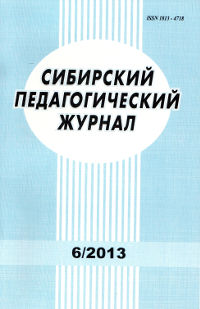Analysis of Interdisciplinary Relations of Integrative Approach
1. Pokrovskaya, M. V., Lunina, I. N., 2016. Engineering graphics: theory and practice of inter-subject connections. Science and Education. MSTU named after N. E. Bauman, no. 11, pp. 175–188. (In Russ.)
2. Dauletkeriev, A. R., 2017. Features of differentiation and integration of science in modern conditions, no. 6 [online]. Society: philosophy, history, culture. Available at: https://cyberleninka.ru/article/n/osobennosti-differentsiatsii-i-integra.... (accessed 18.09.2023). (In Russ)
3. Bloch, Arthur, 2004. Murphy’s Laws / [translated from English by E. G. Handel]. Minsk: Popurri, 253 p. (In Russ.)
4. Sharifzoda, F., 1997. Theory and practice of integrated learning at the initial stage of secondary school. Dr. Sci. (Pedag.). Dushanbe, 49 p. (In Russ.)
5. Parakhonskiy, A. P., Venglinskaya, E. A., 2009. Integration and differentiation of sciences, their connection with education. Advances in modern natural science, no. 9, pp. 86–87. (In Russ.)
6. Savchenko, T. L. Interdisciplinary links in pedagogy [online]. Available at: https://nsportal.ru/shkola/raznoe/library/2013/12/13/mezhpredmetnye-svya... (accessed 29.10.2023). (In Russ.)
7. An, S. A., 2016. Preservice teachers’ knowledge of interdisciplinary pedagogy: the case of elementary mathematics–science integrated lessons. ZDM, no. 49 (2), pp. 237–248. DOI: 10.1007/s11858-016-0821-9. URL: https://www.utep.edu/education/stemmers/resources/an-2017-zdm.pd
8. Ertskina, E. B., Korolkova, N. N., 2021. The role of interdisciplinary links of developing technical students’ professional competence. Education and society, no. 4, pp. 82–92. (In Russ.)
9. Blackshields, D., Cronin, J., Higgs, B., Kilcommins, S., McCarthy, M., Ryan, A., eds., 2014. Integrative Learning: International research and practice. 1st ed. Routledge. 336 p. DOI: https://doi.org/10.4324/9781315884769 (In Russ.)
10. Chasovskikh, G. A., Klikunova, E. V., 2021. To the question of the return of drawing to school. Pedagogical Search, no. 3, pp. 27–31. (In Russ.)
11. Monge, G., 1947. Descriptive geometry. Leningrad: Izd-e of the Academy of Sciences of the USSR, 292 p. (In Russ.)
12. Torhova, E. K., Kungurtseva, N. Yu., 2012. History of the development of descriptive geometry: textbook [online]. Izhevsk, 14 p. Available at: http://elibrary.udsu.ru/xmlui/bitstream/handle/123456789/10094/2012715 (accessed 03.10. 2023). (In Russ)
13. Dmitrieva, I. M., Ivanov, G. S., Seregin, V. I., Muravyev, K. A., 2013. Interdisciplinary connections of descriptive geometry and related sections of higher mathematics. Geometrics and graphics, no. 3, pp. 8–12. (In Russ.)




